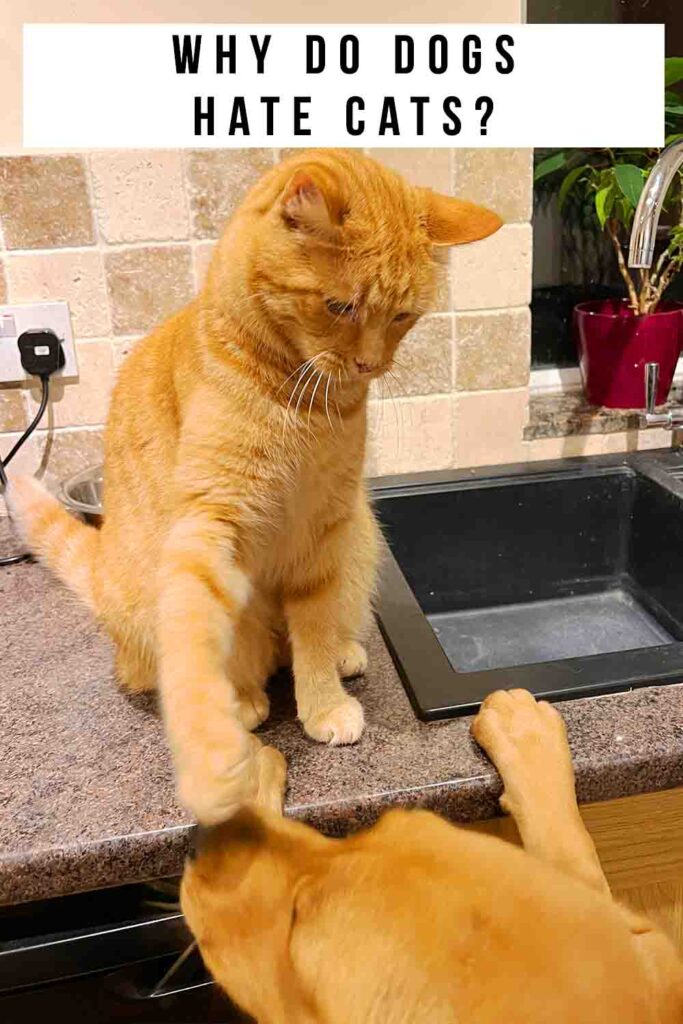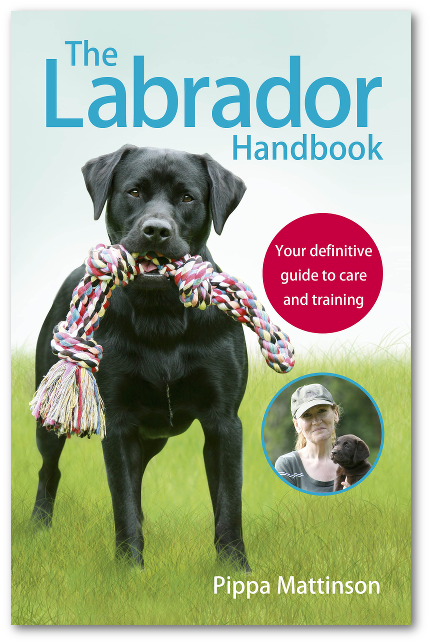Why do dogs hate cats? Dogs’ hatred of cats is legendary. Indeed, my own dog loudly chases cats out of our yard the moment he sets eyes on them. But surveys of people with pet cats and dogs living under the roof suggest that most of them live together very harmoniously. What’s more, when dogs and cats don’t get on, it’s more likely to be the cat who doesn’t like the dog, than the other way round. So let’s take a deeper look at how dogs and cats feel about one another, and what the ingredients are for domestic bliss, if you want to join the growing number of pet parents who have both species.
Contents
- Do dogs hate cats?
- Why do some dogs seem to hate cats?
- Dog and cat dynamics
- How to help your dog and cat get along
Do dogs hate cats?
There’s an enduring idea in jokes and storytelling that dogs and cats do not get on. For example Spike the dog, and his slapstick vendetta against Tom in the Tom & Jerry cartoons. The idea that canines and felines are locked in perpetual rivalry even gave us the much-used phrase ‘fighting like cats and dogs’, to describe people who often have angry arguments.
Despite all this though, there’s not a lot of evidence that dogs actually do hate cats. In a 2020 survey of 1270 people who owned both species, nearly two thirds reported that their dog and cat pets played together. One quarter said that their dogs and cats would take it in turns to groom each other. And nearly 70% of respondents said their cats and dogs slept together some or all of the time. This portrait of domestic harmony corresponds with smaller surveys in 2008 and 2018, which both concluded that most cats and dogs living together under one roof get on well.

But what about the dogs and cats that don’t get on? Well, about 30% of owners completing the 2020 survey said their dogs simply ignored their cat. Just 3% said their dog showed signs of aggression towards their cat. And 1.5% said their dog ran away whenever their cat entered the room!
Why do some dogs seem to hate cats?
So it seems pretty unusual for a dog to genuinely hate a cat that they live with. Here’s what’s likely to be going on when dogs don’t seem to like cats
- Misinterpreting their behavior
- Inadequate socialization
- Instincts taking over
- The cat started it
- Familiar vs unfamiliar felines
Misinterpreting their behavior
Lots of dogs will try to play with a cat when they meet them – they are one of the very few species who try to play with individuals from other species. Behaviors dogs use to try and initiate play can sometimes be excited, fast and noisy. Such as barking or chasing at the target to grab their attention and get the game going. And sometimes what’s intended in a friendly way can even look a aggressive or hostile to human observers. This mistaken impression can be further reinforced if the cat rejects the invitation by hissing or swiping at the dog.
Inadequate socialization
Some dogs’ behavior towards cats can be explained by the fact that they didn’t meet any cats during the all-important socialization window between birth and 12 to 14 weeks old. Socialization acts as a kind of desensitization – puppies who are well socialized to cats are less likely to have fear-driven responses to cats in later life. On the other hand, puppies who never meet a cat growing up might react aggressively towards them, out of fear of the unknown. That being said though, researchers have observed that even dogs who aren’t raised with cats are very likely to try and play with them as adults.
Instincts taking over
Some dogs have instinctive behaviors which look a bit like hatred. For example sighthounds and herding dogs with a strong chase instinct might run after a cat simply because it moves. It’s not a cat thing, it’s a chasing thing! Likewise, most terriers will bark at unusual things appearing in their environment, and they are very likely to bark vigorously at the neighbor’s cat arriving in their yard. It’s not a reflection of how they feel about cats – they’re just hardwired to sound an alert when anything changes.
The cat started it
In one survey of 748 cat-and-dog homes, the researchers observed that the feline subjects injured or threatened the dogs more often than vice versa. So some dogs with a deep seated mistrust of cats might not be completely irrational. They might have learned from bitter experience that some cats aren’t friendly, and try to pre-emptively warn them off.
Familiar vs unfamiliar felines
Most of the research into inter-species relationships between dogs and cats comes from surveys of people who own both. So it doesn’t take into account how dogs feel about unfamiliar cats from outside their household. Through a combination of the factors above – such as lack of socialization to cats, and instincts to behave in specific ways – some dogs just aren’t very compatible with cats. I think this is the case with my own dog, a Whippet who never laid eyes on a cat until he was about 16 weeks old.
Dog and cat dynamics?
The relationship dynamics between dogs and cats go beyond straightforward love or hate. Over the years, researchers have published all kinds of fascinating observations which help us to understand how our pets feel about each other.
For example, it’s pretty well known that canines and felines communicate through body language very differently. For example, when dogs wag their tail it’s usually a sign of joy, or friendliness. But when cats wag their tail, it’s a signal of hostility. Despite this, both species are remarkably good at understanding the the other’s genuine meaning, and not mistaking their body language for having the opposite meaning. Which probably plays an important role in why they are able to get on so well after all.
Also, when dogs and cats live together, owners usually feel that it’s the cat who decides the terms of their relationship. The dog is more likely to try and engage with the cat and make physical contact, and the cat makes it clear how much of that they’re going to tolerate! And finally, even dogs not raised with cats are likely to try and interact with them as adults. But, cats only tend to reciprocate if they were raised alongside dogs as kittens.
How to help your dog and cat get along
It’s increasingly common to keep both dogs and cats in the same household. And they generally get along well. Some steps to increase the likelihood of domestic harmony include:
- Choosing puppies and kittens from breeders who also have both cats and dogs, and who can start socializing one species to the other from a young age.
- Getting the cat first. In owner surveys, dogs were more likely to react badly to the arrival of a cat than vice versa. Dogs raised alongside cats also tended to have better manners and be more gentle towards cats.
- Make sure that your cat has space to get away from your dog when they want to.
- Feed them in separate places – most owners feed their dog on the floor, and their cat on a kitchen work surface, so the dog can’t polish off their meal!
- Make sure there are plenty of sleeping places and toys available, so that they don’t have to compete.
A factor which does not seem to matter is sex – any combination of male or female dog and male or female cat is equally likely to have a good relationship.
Why do dogs hate cats – summary
Cats and dogs are living together more than ever before, and mostly happily. Which gradually putting paid to the old myth that dogs hate cats. In fact, the majority of dogs don’t hate cats at all, and they are actually incredibly open to social relationships with animals from other species. Let us know which animals are your dog’s favorites, and how they feel about felines, in the comments box down below!
The Labrador Site Founder
Pippa Mattinson is the best selling author of The Happy Puppy Handbook, the Labrador Handbook, Choosing The Perfect Puppy, and Total Recall.
She is also the founder of the Gundog Trust and the Dogsnet Online Training Program
Pippa's online training courses were launched in 2019 and you can find the latest course dates on the Dogsnet website


















